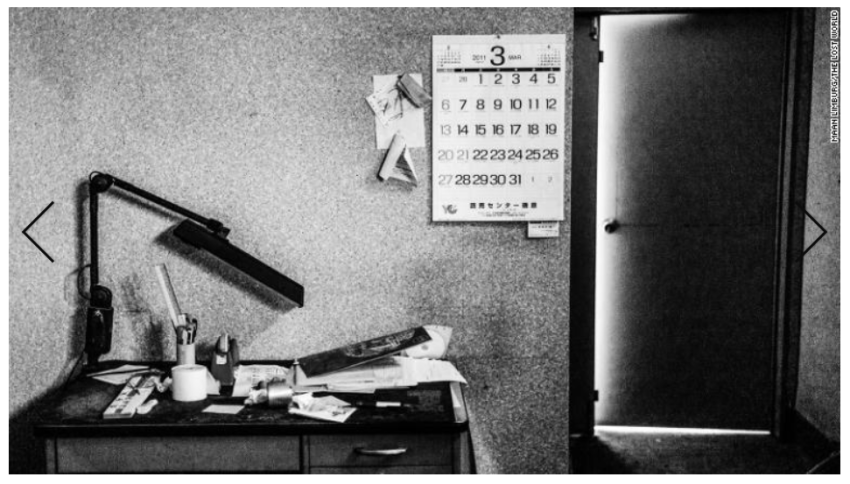英文解読練習として英語のニュースから日本語に翻訳された記事をよく読んでいますか?このコーナーではそんな世界の面白いニュースとその日本語訳をピックアップしてご紹介します。リーディングや外国人に話しかける時にも、緊張をほぐして、会話のきっかけとしていかがですか?
英語:“’The Lost World’: New book highlights Japan’s abandoned rural spaces”
Simply saying the word “Japan” can bring up images of manga, maid cafes and neon lights.
But for Dutch photographer Maan Limburg, Japan is a series of rural landscapes punctuated by empty houses.
Her photographs of these places — from houses departed in the wake of natural disasters to closed-down theaters with the lights still cued up — are now featured in a book, “The Lost World,” which published in May.
Japan has one of the oldest populations in the world, with an estimated one in every 1,500 people over the age of 100. As more young people move to the cities in search of jobs, rural areas have become more difficult to maintain.
And that’s not the only major force affecting Japan’s landscape. Events like earthquakes, typhoons and the Fukushima nuclear disaster have also caused widespread destruction or abandonment.
Enter the phenomenon of akiya, or ghost houses.
A 2014 government report sounded the alarm, saying that, should things continue at the present rate, about 900 villages and towns throughout Japan will be “extinct.”
The abandoned house crisis is so great that some areas are even giving homes away for free.
But even free houses aren’t necessarily the cure for Japan’s akiya situation. While other countries with aging populations, like Italy, have given away or sold very cheap houses to foreigners, they often come with a visa or residency permit attached. Japan’s houses, though, do not.
As a result, it can be hard to find people willing to live in the homes and fix them up, especially if they don’t speak Japanese or have access to a car.
Limburg, who is based in Utrecht, found herself irresistibly pulled to the lesser-known regions of Japan where many of these houses exist. She and her partner spent months there at a time, renting a car or van and driving through parts of the country that many tourists rarely explore.
Limburg says she “fell in love” with rural Japan.
“Every village we got to, the people were like, ‘What are you doing here? The nearest tourist attraction is 35 kilometers. We can send you there. We can draw you a map if you want to.’ It was just really nice to see this different side of Japan,” she says.
And once she began visiting smaller villages, it was practically impossible not to find empty homes or abandoned buildings. At one point, Limburg says, her boyfriend asked if they really had to stop at every single one.
One of the reasons Limburg connected with rural Japan is that it reminded her of her native Netherlands. Though both countries have a reputation for being cold and not always welcoming to foreign visitors, Limburg disagrees.
“As soon as Dutch people see you’re actually interested, they will share a lot of information with you. That’s something I also really found in Japan to be true,” she says. “It’s one of the things I really enjoy in both countries that, if you have real interest in the people, suddenly they really share their life with you,”
But of course not all countryside is the same, and that was reflected in the kinds of empty buildings she found.
In Hokkaido, Limburg explains, many people had time to properly close up and weather-seal their houses before moving away. But in areas like Fukushima, where people had fled in a hurry, it wasn’t unusual to find teacups still set out or TV sets still plugged in.
One of her personal favorite discoveries was a former theater. The sets, costumes and lights were still intact, as if the actors had merely taken a lunch break and were due back any minute.
Some of the smaller homes had the most emotional punch. Limburg saw family photos still tacked up on the wall and found herself wondering what had happened to the people who lived here and what had made them leave.
“I hope to have treated the locations with enough respect,” she says.
Her favorite region was the “magical” northern island of Hokkaido.
“it’s rough and it’s rugged and it’s weird,” the photographer says. “We had a feeling that we were in an Edward Hopper painting without any people.”
In all, Limburg has visited Japan about 10 times, beginning when she was a teenager.
Because she is a freelancer, she’s able to spend long periods of time away, so her average Japan visit was three weeks. Multiple trips enabled her to see different parts of the country, as well as to meet and connect with some of the people she encountered along the way.
“The Lost World” is more than just a photo book — it’s an homage to the country she loves and respects.
Copyright 2022 Cable News Network.
原文を読む≫
日本語:“全国の空き家を訪ねて――オランダ人写真家が撮った「もうひとつの日本」”
外国人が「日本」と聞いて連想するのは漫画やメイドカフェ、ネオンのイメージかもしれない。だがオランダ人のフリー写真家、マーン・リンブルフ氏の目を引いたのはそのどれでもなく、空き家が点在する農村部の風景だった。
同氏が5月に発売した本のタイトルは、失われた世界を意味する「The Lost World」。突然の天災で住人が避難したままの民家や、閉鎖されてしまった劇場などの写真が紹介されている。
日本は世界の中でも人口の高齢化が進んだ国として知られる。若者たちは職を求めて都会へ移り、農村部の維持管理は難しさを増している。さらに地震や台風、福島第一原子力発電所のような事故が原因で、多くの土地が荒廃していく。
政府は2014年に出した報告書の中で、このままのペースだと全国で900前後の村や町が消滅すると警告した。
一部の地方は深刻な空き家問題を解決しようと、民家を無料で譲り渡しているが、それで空き家問題が解決するわけではない。
イタリアなどで外国人に対して安価に提供される空き家にはよく査証(ビザ)や滞在許可証が付いているが、日本の場合はそうもいかない。外国人は日本語を話せなかったり、車が使えなかったりするケースも多く、そうなると空き家を修繕しながら住みたいという希望者を見つけるのは難しい。
オランダ中部ユトレヒト在住のリンブルフ氏は、恋人の男性とともに日本を訪れ、毎回3週間ずつ滞在してきた。観光客はほとんど足を踏み入れないような場所を、レンタカーでめぐった。
リンブルフ氏は日本の農村部と「恋に落ちた」と話している。行く先々の村で、住民から「なぜこんな所にいるの」「最寄りの観光地はここから35キロ。よろしければ地図を描きましょうか」と声を掛けられた。日本のもうひとつの面を見るのは本当に楽しかったと、同氏は振り返る。
小さい村を回り始めてみると、そこには必ずといっていいほど空き家や廃墟があった。
リンブルフ氏が日本に親しみを感じる理由のひとつは、生まれ故郷のオランダを思い出すからだという。どちらの国も外国人に冷たく、必ずしも歓迎ムードではないといわれるが、同氏の意見は違う。どちらの国でも、自分がそこの人々に本気で関心を示せば、相手は心を開いてくれるという。
もちろん田舎ならどこも同じというわけではなく、その違いは空き家に表れている。北海道では多くの人が家を出る前、戸締りや雨漏り防止の作業に時間を費やした跡がみられるのに対し、住人があわただしく避難した福島のような例では、茶わんが出ていたりテレビがコンセントにつながったままだったりする。
かつて劇場だった建物はお気に入りのひとつだ。舞台装置や衣装、照明もそのままで、役者たちは今昼休みを取っているだけ、いつ戻ってきてもおかしくないと思わせる。
小さな家の壁に飾られた家族の写真を見て、ここの住人に一体何が起きたのだろう、どうして出て行かなければならなかったのだろうと、思いにふけってしまうこともある。
訪問先には十分に敬意を払っているつもりだ。10代のころから数えて、これまでに計10回ほど日本を訪れてきた。「The Lost World」は単なる写真集ではなく、同氏が敬愛する日本という国へのオマージュだ。
Copyright 2022 Cable News Network.
原文を読む≫
